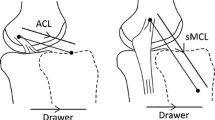Summary
The treatment of serious sprains and chronic laxity of the knee calls for a knowledge of the mechanical properties of the stabilizing structures. The mechanical characteristics indicate an elasticity rate of from 21 to 30% for the cruciate ligaments and average of 11% for the lateral ligments. Preservation methods markedly influence mechanical properties. In the case of chronic laxity, natural ligaments can be replaced by artificial ones. This comparative biomechanical study of natural and artificial ligaments provides a classification to help the user in his choice.
Résumé
Les méthodes thérapeutiques des entorses graves et des laxités chroniques du genou nécessitent une connaissance des propriétés mécaniques des structures de stabilisation. Les caractéristiques mécaniques des ligaments croisés objectivent un pourcentage d'élasticité compris entre 21 et 30% pour les ligaments croisés et 11 % en moyenne pour les ligaments latéraux. Les propriétés mécaniques sont influencées par les méthodes de conservation. Un ligament artificiel remplace un ligament naturel dans le cas d'une laxité chronique. Le résultat d'une étude biomécanique comparative entre ligaments naturels et artificiels permet d'optimiser le choix de l'utilisateur.
Similar content being viewed by others
References
Alm M, Ekström H, Stromberg B (1974) Tensile strength of the anterior cruciate ligament on the dog. Acta Chir Scand 445: 15–23
Beauchamp P, Laurin CA (1976) Le ligament croisé antérieur: notions actuelles. Union Med Can 105: 1380–1386
Brantigan OC, Voshell AF (1941) The mechanics of the ligaments ant menisci of the knee joint. J Bone Joint Surg [Am] 23: 44–46
Fischer L, Gonon GP (1978) Résistance mécanique des ligaments croisés. Lyon, communication orale
Girgis FG, Marshall JL, Almonajem ARS (1975) The cruciate ligaments of the knee joint. Anatomical functional and experimental analysis. Clin Orthop 106: 216–220
Kapandji IA (1980) Physiologie articulaire. Tome II. Maloine, Paris
Kennedy JC, Hawkins RJ, Willis RW, Danyl-Chuck KD (1976) Tension studies of human knee ligaments. J Bone Joint Surg [Am] 58: 350–355
Noyes FR, Grood ES (1976) The strength of the anterior cruciate ligament in humans and rhesus monkeys age-related and speciesrelated changes. J Bone Joint Surg [Am] 58: 1074–1076
Smillics IS (1918) The diagnosis and treatment of injuries to the crucial ligaments. Br Surg 6: 176–180
Author information
Authors and Affiliations
Rights and permissions
About this article
Cite this article
Bonnel, F., Micaleff, J.P. Biomechanics of the ligaments of the human knee and of artificial ligaments. Surg Radiol Anat 10, 221–227 (1988). https://doi.org/10.1007/BF02115241
Received:
Accepted:
Issue Date:
DOI: https://doi.org/10.1007/BF02115241




